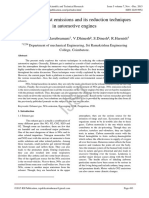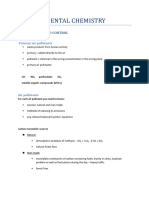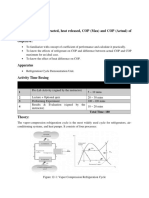Professional Documents
Culture Documents
Practical 12: To Study The Effect of Residual Gasses On Environment
Practical 12: To Study The Effect of Residual Gasses On Environment
Uploaded by
Muhammad Arslan AfzalOriginal Description:
Original Title
Copyright
Available Formats
Share this document
Did you find this document useful?
Is this content inappropriate?
Report this DocumentCopyright:
Available Formats
Practical 12: To Study The Effect of Residual Gasses On Environment
Practical 12: To Study The Effect of Residual Gasses On Environment
Uploaded by
Muhammad Arslan AfzalCopyright:
Available Formats
Practical 12
To study the effect of residual gasses on environment.
Introduction:
A mixture of gases derived as by-product from the distillation of crude oil and the
processing of oil products in refineries and the chemical industry. The mixture
consists mainly of hydrogen, methane, ethane and carbon dioxide OR The gases
that remain in the cylinder of an internal-combustion engine after the exhaust
stroke has been completed. Residual gases contain combustion products and
nitrogen. Before combining with the incoming fuel-air mixture, residual gases
have a temperature between 700° and 800°C. They constitute from 8 to 15 percent
of the weight of fresh charge in the cylinder. The contents of cylinders in an idling
engine have the maximum possible proportion of residual gases 25 percent. For
every percent of weight of the mixture of fresh charge and residual gases that is
contributed by the residual gases, the air-fuel mixture is warmed by 8° to 10°C. As
compression in the cylinder increases, both the absolute and relative amounts of
residual gases in the cylinder decrease.
Residual Gasses in gas turbine power plants
and automobiles Power Plants
Combustion gas in gas turbine power plants generally consists of CO 2, SO2, O2,
N2, and H2O on the based on complete combustion. The gas volume generated
from a unit mass of fuel is called combustion gas volume on a wet basis. The
measurement of component analysis of combustion gas is carried out after
removing water vapour. The volume excluding water vapour from the combustion
gas is referred as combustion gas volume on a dry basis. The combustion is
sometimes incomplete, which may be at times occurred for the purpose of NOx
reduction. At the incomplete combustion, unburned carbon, carbon monoxide,
hydrogen, and unburned hydrocarbons are contained in the combustion gas. On
the combustion equipment for power generation, hydrogen and unburned
Hydro-carbons are rarely generated and can be ignored. Therefore, CO is
considered as the product of incomplete
combustion.
The work carried out showed strong air
pollution in the cities. The application of
satellite imagery shows a significant
heterogeneity in the distribution of NO
in the atmosphere, with heavier NO2
concentrating in the lower and NO in the
upper layers of the atmosphere. The
most dangerous consequences from the
ecological point of view for the person and the nature caused by some products of
combustion of fuels. The quality of fuels has significant effect on formation of
harmful emissions. Undesirable is the presence in the fuels of large amounts of
olefinic and aromatic hydrocarbons, sulfur, ash components.
The qualitative and quantitative indicators of the release of harmful pollutants with
exhaust gases of vehicles during their transport work are ambiguous and depend
on many factors:
On the type of the used fuel.
From the design, conditions and operating conditions of the engine.
On the amount of the done work.
On the type and characteristics of the car’s movement.
In particular, the percentage of residual gas fraction (RGF) in the engine cylinder
can significantly alter the temperature and composition of the working fluid as
compared with the air-fuel mixture inducted into the engine, thus affecting engine-
out emissions. Accurate measurement of the RGF is cumbersome and expensive,
thus making it hard to accurately characterize the initial mixture composition and
temperature in any given engine cycle. This uncertainty can lead to challenges in
accurately interpreting experimental emissions data.
Numerical results show that small uncertainties (~2–4%) in the measured values of
the RGF can significantly affect the engine-out NO/CO emissions.
Impact of residual Gases On Environment:
Composition of exhaust gases of internal combustion engines, vol. %.
Components Gasoline engine Diesel engine
Nitrogen 74-77 76-78
Oxygen 0.3-8 2-18
Water 3,55 0,5-4
Carbon dioxide 5-12 1-10
СО 1-10 0.01-0.5
NOx 0.1-0.5 0.001-0.4
SO x 0-0.002 0-0.03
Hydrocarbons 0.01-0,1 0.01-0.5
Aldehydes 0-0.2 0-0.009
Soot, g/m3 0-0.04 0.01-1.1
Benz(a) pyrene to 0.00002 to 0.00001
Except direct negative impact on health of the
person, emissions of the motor transport have
greenhouse and ozone-depleting effect on the
atmosphere of the earth. It is connected with
the content in the fulfilled gases of the engine
of the following substances:
Carbon dioxide CO2, the main component in
the exhaust gases of the engine, creating a
greenhouse effect in the atmosphere
(greenhouse gas);
Methane CH4,
Ammonia NH3,
Nitrous oxide N2O – greenhouse and ozone-depleting substances contained in the
exhaust gases of the engine.
Techniques to reduce the effect of residual gasses
Automobile Use of In-Cylinder Catalyst
The use of an in-cylinder catalyst (on glow plugs) during diverse engine operating
conditions results in a few percent reduction in the mass of carbon monoxide,
hydrocarbons, carbon dioxide and the number of solid particles.
A) In Automobiles:
Catalytic Converters:
Among all the ways to reduce the
toxicity of man-made emissions into
the atmosphere, catalytic oxidation
of harmful components is one of the
promising methods of improving the
atmosphere. The applicability of the
latest catalytic systems requires the
presence of sophisticated electronic
control systems for the combustion
process in the engine, which is
interrelated with a constant rapid analysis of the quality of the neutralizer
and the composition of the exhaust gases.
It is very important to reduce emissions of NO2 and particulate matter (soot),
conducting qualitative tests of catalysts in real conditions for obtaining more
complete information on the operation of catalytic converters.
It is necessary to tighten regulatory emissions in a legislative way because
the purification of exhaust gases from motor vehicles and chemical
industries is a scientific, technical and social problem.
Use of a platinum metals catalyst:
The use of a platinum metals catalyst in the combustion chamber of an
internal combustion engine offers an opportunity to develop an engine
which emits particularly low levels of nitrogen oxides while giving the fuel
economy generally associated with an un-throttled engine, such as a diesel.
Using Catalytic Engine:
By using a catalytic engine. A catalytic engine is an internal combustion
engine where the heat release is brought about by the use of a catalyst. This
definition includes engines where the combustion is commenced, sustained,
or aided by the action of a catalyst on the air/fuel mixture.
Adjusting Air Fuel Ratio
There is therefore a need for a method of combustion which would enable
very lean mixtures to be efficiently oxidised, and operate in an internal
combustion engine at a compression ratio of about 12:1.
B) In Power Plants:
Control on Excessive Emissions:
Adopting new technology, efficient training of employees for safe use and
development of better technology for disposal of waste, and being more
conscientious about the use of raw materials can help control industrial
pollution at the source.
Proper Waste Treatment:
By developing and implementing adequate treatment facilities for handling
industrial waste and proper habits can reduce pollution.
Turning Waste Gases Into Power:
Different mechanisms should be developed to reuse the wasted gases which
are left into environment by re-combustion or other methods.
Treatment of Gases with Humic Acid:
Humic acid (HA) is a natural adsorbent and has special physical and
chemical characteristics that form the foundation for disposal of pollutants
from a combustor flue gas. HA, which occurs widely in soil, water, and low
rank coals, has already been proposed as a candidate that can be used as a
sorbent for air pollution control.
Conclusion:
In this experiment we have seen that what are residual gases and what are
the effects of the residual gases on the environment and the measures that
can be taken to reduce the harmful effects of residual gases on the
environment.
You might also like
- Internship PresentationDocument22 pagesInternship PresentationCalvin WongNo ratings yet
- "Effect of Exhaust Gas Recirculation (Egr) On Nox Emission From C.I. Engine" - A Review StudyDocument5 pages"Effect of Exhaust Gas Recirculation (Egr) On Nox Emission From C.I. Engine" - A Review StudyShreyash BalpandeNo ratings yet
- Irjet V6i10181Document3 pagesIrjet V6i10181Chirag PatilNo ratings yet
- "Effect of Exhaust Gas Recirculation (Egr) On Nox Emission From C.I. Engine" - A Review StudyDocument5 pages"Effect of Exhaust Gas Recirculation (Egr) On Nox Emission From C.I. Engine" - A Review Studyslv_prasaadNo ratings yet
- Sem (Autosaved) (Autosaved)Document25 pagesSem (Autosaved) (Autosaved)Behab PatnaikNo ratings yet
- Recent Development in Marine EnginesDocument81 pagesRecent Development in Marine EnginesShashidhar ChandraiahNo ratings yet
- Report AJUDocument20 pagesReport AJUTHE DARK KNIGHTNo ratings yet
- Structured Catalysts For Soot Combustion For Diesel Engines: E.D. Banús, M.A. Ulla, E.E. Miró and V.G. MiltDocument26 pagesStructured Catalysts For Soot Combustion For Diesel Engines: E.D. Banús, M.A. Ulla, E.E. Miró and V.G. MiltYuva RajNo ratings yet
- Exhaust Emissions and Its Control Methods in Compression Ignition Engines: A ReviewDocument12 pagesExhaust Emissions and Its Control Methods in Compression Ignition Engines: A ReviewPiyush RaiNo ratings yet
- Yadav AdBlueDocument9 pagesYadav AdBlueguilherme lacerdaNo ratings yet
- Exhaust Emissions and Its Control Technology For An Internal Combustion EngineDocument14 pagesExhaust Emissions and Its Control Technology For An Internal Combustion EngineAshish KumarNo ratings yet
- Unit - 4 Part - A: I. HydrocarbonsDocument20 pagesUnit - 4 Part - A: I. HydrocarbonsJVCNo ratings yet
- Exhaust Gas Recirculation System: October 2015Document7 pagesExhaust Gas Recirculation System: October 2015Luyen NguyenNo ratings yet
- A Review of Biogas Utilisation, Purification and Upgrading TechnologiesDocument17 pagesA Review of Biogas Utilisation, Purification and Upgrading TechnologiesXavier OrtizNo ratings yet
- Study On Exhaust Emissions and Its Reduction Techniques in Automotive EnginesDocument5 pagesStudy On Exhaust Emissions and Its Reduction Techniques in Automotive EnginesShreyash BalpandeNo ratings yet
- What You Require To Know About NOx Reduction.20130104.123704Document2 pagesWhat You Require To Know About NOx Reduction.20130104.123704anon_931869105No ratings yet
- A Review Study of The Effect of Exhaust Gas Recirculation (EGR) On Performance and Emission Characteristics of Diesel EngineDocument8 pagesA Review Study of The Effect of Exhaust Gas Recirculation (EGR) On Performance and Emission Characteristics of Diesel EngineEis NovidhaNo ratings yet
- The Composition of Exhaust Gases From Diesel Gasoline and Propane Powered Motor CoachesDocument7 pagesThe Composition of Exhaust Gases From Diesel Gasoline and Propane Powered Motor CoachesAhmad BilaalNo ratings yet
- I Petroleum Products and EnvironmentalDocument67 pagesI Petroleum Products and EnvironmentalSami Onur VuralNo ratings yet
- Diesel Exhaust Gas AftertreatmentDocument16 pagesDiesel Exhaust Gas AftertreatmentlukhmanNo ratings yet
- A Review of Biogas UtilisationDocument17 pagesA Review of Biogas UtilisationKhangDươngNo ratings yet
- 1 s2.0 S0016236103000346 Main.13Document5 pages1 s2.0 S0016236103000346 Main.13luuphuongNo ratings yet
- Exhaust Gas Recirculation SystemDocument7 pagesExhaust Gas Recirculation Systemmalik visheshNo ratings yet
- Exhaust Emissions and Its Control Technology For An Internal Combustion EngineDocument14 pagesExhaust Emissions and Its Control Technology For An Internal Combustion Enginerb andhaleNo ratings yet
- Full Length Article: SciencedirectDocument9 pagesFull Length Article: SciencedirectImran DahalanNo ratings yet
- APC Full Notes PDFDocument104 pagesAPC Full Notes PDFAkil KumarNo ratings yet
- The Effect of Low-Carbon Fuel On Trace Metals, Organic Compounds, Gaseous and Particulate Species From A Euro Iv Diesel Engine at Steady-State ModeDocument12 pagesThe Effect of Low-Carbon Fuel On Trace Metals, Organic Compounds, Gaseous and Particulate Species From A Euro Iv Diesel Engine at Steady-State ModeTJPRC PublicationsNo ratings yet
- Selective Catalytic ReductionDocument15 pagesSelective Catalytic ReductionJuan Esteban EnriquezNo ratings yet
- Emissions Lecture-4Document41 pagesEmissions Lecture-4Soumya Ranjan SahooNo ratings yet
- HoribaDocument17 pagesHoribaAzim YusoffNo ratings yet
- Exhaust Emission: Department of Mechanical Engineering, CUETDocument11 pagesExhaust Emission: Department of Mechanical Engineering, CUETonikNo ratings yet
- Exhaust Emission Reduction Technologies For Diesel Engines: Pankaj Gupta 142116517 Stress and VibrationDocument25 pagesExhaust Emission Reduction Technologies For Diesel Engines: Pankaj Gupta 142116517 Stress and VibrationTushar RadkarNo ratings yet
- Nox Reduction by Using Urea Injection and Marine Ferromanganese Nodule As SCR of A Diesel Engine Fulled With Soybean Oil Methyl Ester (Some)Document7 pagesNox Reduction by Using Urea Injection and Marine Ferromanganese Nodule As SCR of A Diesel Engine Fulled With Soybean Oil Methyl Ester (Some)IOSRJEN : hard copy, certificates, Call for Papers 2013, publishing of journalNo ratings yet
- Lecture - 6 Exhaust Gas RecirculationDocument47 pagesLecture - 6 Exhaust Gas RecirculationUmar ChNo ratings yet
- Applied Chemistry Combined TRDocument247 pagesApplied Chemistry Combined TRanesu taperaNo ratings yet
- ENV315 - Online Air Pollution Control Lecture 11Document23 pagesENV315 - Online Air Pollution Control Lecture 11Samim JubayerNo ratings yet
- Session 25 Emission Measuring Equipment - HC, Co and No Oxides of NitrogenDocument4 pagesSession 25 Emission Measuring Equipment - HC, Co and No Oxides of NitrogenvijayakumarNo ratings yet
- The Potential of A WaterinDiesel Emulsion For Increased Engine Performance and As An Environmentally Friendly FuelMATEC Web of ConferencesDocument5 pagesThe Potential of A WaterinDiesel Emulsion For Increased Engine Performance and As An Environmentally Friendly FuelMATEC Web of ConferencesLuckas MahendraNo ratings yet
- (Document Title) : For Engine To Reduce Oxides of Nitrogen Is Chosen For Present WorkDocument22 pages(Document Title) : For Engine To Reduce Oxides of Nitrogen Is Chosen For Present WorkrassNo ratings yet
- Megawati, Catur Rini Widyastuti, Khairatun Nisa, RatnaningrumDocument9 pagesMegawati, Catur Rini Widyastuti, Khairatun Nisa, RatnaningrumDevinda RANo ratings yet
- Nox Emissions and Its Control: Abhishek Pundir (16105049)Document27 pagesNox Emissions and Its Control: Abhishek Pundir (16105049)SavitarNo ratings yet
- Urban Transportation Environment: Two Days Seminar On " "Document16 pagesUrban Transportation Environment: Two Days Seminar On " "SEEMA NIHALANINo ratings yet
- IC Engine Emissions and Emission ControlDocument44 pagesIC Engine Emissions and Emission ControlGautam GunjanNo ratings yet
- Jurnal ZeolitDocument14 pagesJurnal ZeolitWini NafisyahNo ratings yet
- Pollutants Produced by A Car Engine: GasolineDocument16 pagesPollutants Produced by A Car Engine: GasolineHarpreet RandhawaNo ratings yet
- 2-Literature ReviewDocument39 pages2-Literature ReviewhatemelghazaliNo ratings yet
- REPORT HDS - EditedDocument28 pagesREPORT HDS - EditedARSAL HASHMINo ratings yet
- Nox Reduction Using RDF (Refuse Derived Fuel) in Cement IndustryDocument8 pagesNox Reduction Using RDF (Refuse Derived Fuel) in Cement IndustryIzaz Ulhaq YousafziNo ratings yet
- Effect of HHO Gas On Combustion Emissions in Gasoline EnginesgDocument5 pagesEffect of HHO Gas On Combustion Emissions in Gasoline EnginesgNam stareNo ratings yet
- Vanos: Journal of Mechanical Engineering EducationDocument10 pagesVanos: Journal of Mechanical Engineering EducationirawanNo ratings yet
- Effect of Ignition Delay (ID) On Performance, Emission and Combustion Characteristics of 2-Methyl Furan-Unleaded Gasoline Blends in A MPFI SI EngineDocument10 pagesEffect of Ignition Delay (ID) On Performance, Emission and Combustion Characteristics of 2-Methyl Furan-Unleaded Gasoline Blends in A MPFI SI EngineDito ArdiantoNo ratings yet
- Effect of EgrDocument10 pagesEffect of EgrSumit JainNo ratings yet
- Review Paper On Catalytic Converter For Automotive Exhaust EmissionDocument6 pagesReview Paper On Catalytic Converter For Automotive Exhaust Emissionpamela garciaNo ratings yet
- Praxair CO2EmissionsReductionCapture WhitepaperDocument10 pagesPraxair CO2EmissionsReductionCapture WhitepaperBryan SaliNo ratings yet
- Emission Control Modue - 5Document16 pagesEmission Control Modue - 5siddharthNo ratings yet
- Mechanisms of Formation of Soot and PM The Lecture ContainsDocument9 pagesMechanisms of Formation of Soot and PM The Lecture ContainsKeval ParmarNo ratings yet
- Mordern Mobility Notes 4thmodDocument20 pagesMordern Mobility Notes 4thmodAnonymousNo ratings yet
- MechDocument14 pagesMechAnonymousNo ratings yet
- Pollotants Emission From Automobiles and Their Control: Submitted To: DR - Manzoor AliDocument6 pagesPollotants Emission From Automobiles and Their Control: Submitted To: DR - Manzoor AlisheikhNo ratings yet
- Carbon Black ProcessDocument4 pagesCarbon Black ProcessAnonymous azD9vQD100% (1)
- Clean Ironmaking and Steelmaking Processes: Efficient Technologies for Greenhouse Emissions AbatementFrom EverandClean Ironmaking and Steelmaking Processes: Efficient Technologies for Greenhouse Emissions AbatementNo ratings yet
- Structure AnalysisDocument15 pagesStructure AnalysisMuhammad Arslan AfzalNo ratings yet
- Experiment No 10 Verifying Characteristics of Bipolar Junction Transistor (BJT) ObjectiveDocument10 pagesExperiment No 10 Verifying Characteristics of Bipolar Junction Transistor (BJT) ObjectiveMuhammad Arslan AfzalNo ratings yet
- M&I Lab 08Document9 pagesM&I Lab 08Muhammad Arslan AfzalNo ratings yet
- Ductility Test of BitumenDocument8 pagesDuctility Test of BitumenMuhammad Arslan AfzalNo ratings yet
- Standard Test To Check The Viscosity of Bitumen: Theory Instructor: Prepared By: CourseDocument12 pagesStandard Test To Check The Viscosity of Bitumen: Theory Instructor: Prepared By: CourseMuhammad Arslan AfzalNo ratings yet
- M&I Lab 09Document11 pagesM&I Lab 09Muhammad Arslan AfzalNo ratings yet
- Compressor, Main Parts, Types and Working Principle: PV NRT P TDocument6 pagesCompressor, Main Parts, Types and Working Principle: PV NRT P TMuhammad Arslan AfzalNo ratings yet
- Practical #11: To Study Cutaway Models of Petrol and Diesel Engine Heat EngineDocument9 pagesPractical #11: To Study Cutaway Models of Petrol and Diesel Engine Heat EngineMuhammad Arslan AfzalNo ratings yet
- California Bearing Ratio TestDocument11 pagesCalifornia Bearing Ratio TestMuhammad Arslan AfzalNo ratings yet
- Name ID Department Arslan Afzal F18602037 Mechanical: Computer Programming For EngineeringDocument4 pagesName ID Department Arslan Afzal F18602037 Mechanical: Computer Programming For EngineeringMuhammad Arslan AfzalNo ratings yet
- Practical 9Document12 pagesPractical 9Muhammad Arslan AfzalNo ratings yet
- Practical 10: To Estimate The Thrust Provided by A Stream of Air On Axial Flow Gas Turbine ObjectiveDocument6 pagesPractical 10: To Estimate The Thrust Provided by A Stream of Air On Axial Flow Gas Turbine ObjectiveMuhammad Arslan AfzalNo ratings yet
- Muthair Saeed, Assignment Week 12Document3 pagesMuthair Saeed, Assignment Week 12Muhammad Arslan AfzalNo ratings yet
- Practical 7: Introduction To Axial Flow Gas Turbine Operations ObjectiveDocument11 pagesPractical 7: Introduction To Axial Flow Gas Turbine Operations ObjectiveMuhammad Arslan AfzalNo ratings yet
- Lab 5 CoverDocument2 pagesLab 5 CoverMuhammad Arslan AfzalNo ratings yet
- 4 Stroke Diesel Engine ArslanDocument5 pages4 Stroke Diesel Engine ArslanMuhammad Arslan AfzalNo ratings yet
- Practical 5: To Study Pressure Temperature Curve For Water in Condensation Unit ObjectiveDocument8 pagesPractical 5: To Study Pressure Temperature Curve For Water in Condensation Unit ObjectiveMuhammad Arslan AfzalNo ratings yet
- Name ID Department Arslan Afzal F18602037 Mechanical: Mechanics of MaterialDocument4 pagesName ID Department Arslan Afzal F18602037 Mechanical: Mechanics of MaterialMuhammad Arslan AfzalNo ratings yet
- 4 STROKE PETROL ENGINE ArsalDocument5 pages4 STROKE PETROL ENGINE ArsalMuhammad Arslan AfzalNo ratings yet
- Arslan Lab 7 F18602037Document4 pagesArslan Lab 7 F18602037Muhammad Arslan AfzalNo ratings yet
- Lab 6Document5 pagesLab 6Muhammad Arslan AfzalNo ratings yet
- Name M Arslan Afzal Lab 6 ID F18602037: IostreamDocument7 pagesName M Arslan Afzal Lab 6 ID F18602037: IostreamMuhammad Arslan AfzalNo ratings yet
- Assignment 1Document3 pagesAssignment 1Muhammad Arslan AfzalNo ratings yet
- Lab 2 Strain GuageDocument5 pagesLab 2 Strain GuageMuhammad Arslan AfzalNo ratings yet
- ĐỀ THI ĐƯỢC 5.8 ĐIỂMMMDocument4 pagesĐỀ THI ĐƯỢC 5.8 ĐIỂMMMKhanh Linh100% (1)
- Phoenix CoolerDocument5 pagesPhoenix Coolerentryscribd100% (1)
- Flute PhysicsDocument12 pagesFlute PhysicskrumiaaNo ratings yet
- Delfi PPT Company and Brand IntroDocument25 pagesDelfi PPT Company and Brand IntroClive MascarenhasNo ratings yet
- Second Moment of AreaDocument20 pagesSecond Moment of AreaGoutham ShajiNo ratings yet
- Selina Solutions For Class 10 Biology Chapter 12 The Endocrine SystemDocument14 pagesSelina Solutions For Class 10 Biology Chapter 12 The Endocrine Systemchirag mahidaNo ratings yet
- Fuel Consumption & THP Table 16-710G3C-ES - GT46ACDocument1 pageFuel Consumption & THP Table 16-710G3C-ES - GT46ACRafael Dutil LucianaNo ratings yet
- Motorola Global Strategy (Final)Document20 pagesMotorola Global Strategy (Final)Citra Dewi WulansariNo ratings yet
- Population and Associated IssuesDocument11 pagesPopulation and Associated IssuesPrathameshNo ratings yet
- Displaying All Possible Colors in Classical Reports (Lists) PDFDocument3 pagesDisplaying All Possible Colors in Classical Reports (Lists) PDFPedro TenorioNo ratings yet
- Questionaire CheckboxDocument22 pagesQuestionaire CheckboxRobNo ratings yet
- Transcend: Ts-Avd3 User S Manual Intel Socket 370 Celeron/ Pentium III FC-PGA Series Cyrix III Joshua SeriesDocument51 pagesTranscend: Ts-Avd3 User S Manual Intel Socket 370 Celeron/ Pentium III FC-PGA Series Cyrix III Joshua SeriesVidelaorNo ratings yet
- Energy Internet: Abstract - Rising Prices of Energy Sources and Inadequacy ofDocument5 pagesEnergy Internet: Abstract - Rising Prices of Energy Sources and Inadequacy ofJunaid Khan JadoonNo ratings yet
- Calibration Guide For XRay71s All-Purpose Bee Swarm Simulator MacroDocument17 pagesCalibration Guide For XRay71s All-Purpose Bee Swarm Simulator MacroAnikNo ratings yet
- Beginners Chest Workout 4 Exercises For Building Bigger PecsDocument7 pagesBeginners Chest Workout 4 Exercises For Building Bigger Pecsfella quiNo ratings yet
- Engineer N Society SlideDocument22 pagesEngineer N Society SlideMohd ShafiqNo ratings yet
- Unit 2 - AnswersDocument49 pagesUnit 2 - AnswersMiguel GalloNo ratings yet
- 4 - Patch SVDD Patch-Level SVDD For Anomaly Detection and SegmentationDocument22 pages4 - Patch SVDD Patch-Level SVDD For Anomaly Detection and Segmentationfarzad imanpourNo ratings yet
- TVL 2 Installation InstructionsDocument11 pagesTVL 2 Installation InstructionsFoeBreezyNo ratings yet
- AcupunDocument125 pagesAcupunleonvichm90% (42)
- Innershield NS-3M: Welding Positions Key FeaturesDocument2 pagesInnershield NS-3M: Welding Positions Key FeaturesGiancarlo BlandinoNo ratings yet
- Example of A Research Paper BodyDocument6 pagesExample of A Research Paper Bodypimywinihyj3100% (1)
- Zinoviev-Madhouse Yellow HouseDocument22 pagesZinoviev-Madhouse Yellow Houseomphalos15No ratings yet
- Hot Work ProcedureDocument16 pagesHot Work ProcedureAkmal YassinNo ratings yet
- Review-Of-Related-Literature 2Document3 pagesReview-Of-Related-Literature 2Christian Paul GaNo ratings yet
- Effects of Nitrogen Flow Rates On The Growth Morphology of TiAlN Films Prepared by An Rf-Reactive Sputtering TechniqueDocument5 pagesEffects of Nitrogen Flow Rates On The Growth Morphology of TiAlN Films Prepared by An Rf-Reactive Sputtering TechniquePhysics MPSTMENo ratings yet
- Https WWW - Ale-Heavylift - Com Wp-Content Uploads 2014 01 EQUIPMENT-DATA-SHEET-500te-Climbing-JackDocument1 pageHttps WWW - Ale-Heavylift - Com Wp-Content Uploads 2014 01 EQUIPMENT-DATA-SHEET-500te-Climbing-JackGia Minh Tieu TuNo ratings yet
- Descriptive WritingDocument3 pagesDescriptive WritingShriya JagwayanNo ratings yet
- Philips Tpm10.1e La - 19439Document223 pagesPhilips Tpm10.1e La - 19439Charly NitroNo ratings yet

















































































































